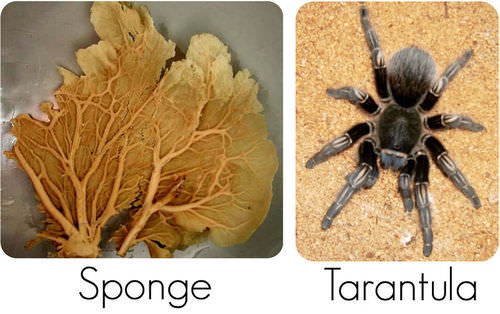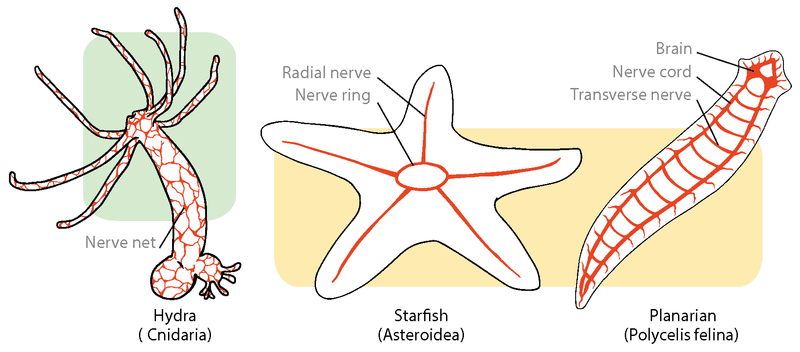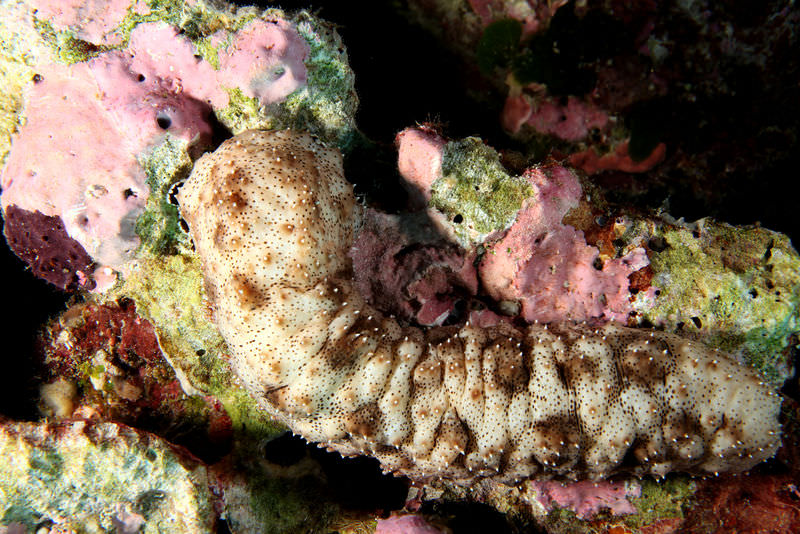11.5: Invertebrate Diversity
- Page ID
- 1386
\( \newcommand{\vecs}[1]{\overset { \scriptstyle \rightharpoonup} {\mathbf{#1}} } \)
\( \newcommand{\vecd}[1]{\overset{-\!-\!\rightharpoonup}{\vphantom{a}\smash {#1}}} \)
\( \newcommand{\dsum}{\displaystyle\sum\limits} \)
\( \newcommand{\dint}{\displaystyle\int\limits} \)
\( \newcommand{\dlim}{\displaystyle\lim\limits} \)
\( \newcommand{\id}{\mathrm{id}}\) \( \newcommand{\Span}{\mathrm{span}}\)
( \newcommand{\kernel}{\mathrm{null}\,}\) \( \newcommand{\range}{\mathrm{range}\,}\)
\( \newcommand{\RealPart}{\mathrm{Re}}\) \( \newcommand{\ImaginaryPart}{\mathrm{Im}}\)
\( \newcommand{\Argument}{\mathrm{Arg}}\) \( \newcommand{\norm}[1]{\| #1 \|}\)
\( \newcommand{\inner}[2]{\langle #1, #2 \rangle}\)
\( \newcommand{\Span}{\mathrm{span}}\)
\( \newcommand{\id}{\mathrm{id}}\)
\( \newcommand{\Span}{\mathrm{span}}\)
\( \newcommand{\kernel}{\mathrm{null}\,}\)
\( \newcommand{\range}{\mathrm{range}\,}\)
\( \newcommand{\RealPart}{\mathrm{Re}}\)
\( \newcommand{\ImaginaryPart}{\mathrm{Im}}\)
\( \newcommand{\Argument}{\mathrm{Arg}}\)
\( \newcommand{\norm}[1]{\| #1 \|}\)
\( \newcommand{\inner}[2]{\langle #1, #2 \rangle}\)
\( \newcommand{\Span}{\mathrm{span}}\) \( \newcommand{\AA}{\unicode[.8,0]{x212B}}\)
\( \newcommand{\vectorA}[1]{\vec{#1}} % arrow\)
\( \newcommand{\vectorAt}[1]{\vec{\text{#1}}} % arrow\)
\( \newcommand{\vectorB}[1]{\overset { \scriptstyle \rightharpoonup} {\mathbf{#1}} } \)
\( \newcommand{\vectorC}[1]{\textbf{#1}} \)
\( \newcommand{\vectorD}[1]{\overrightarrow{#1}} \)
\( \newcommand{\vectorDt}[1]{\overrightarrow{\text{#1}}} \)
\( \newcommand{\vectE}[1]{\overset{-\!-\!\rightharpoonup}{\vphantom{a}\smash{\mathbf {#1}}}} \)
\( \newcommand{\vecs}[1]{\overset { \scriptstyle \rightharpoonup} {\mathbf{#1}} } \)
\( \newcommand{\vecd}[1]{\overset{-\!-\!\rightharpoonup}{\vphantom{a}\smash {#1}}} \)
\(\newcommand{\avec}{\mathbf a}\) \(\newcommand{\bvec}{\mathbf b}\) \(\newcommand{\cvec}{\mathbf c}\) \(\newcommand{\dvec}{\mathbf d}\) \(\newcommand{\dtil}{\widetilde{\mathbf d}}\) \(\newcommand{\evec}{\mathbf e}\) \(\newcommand{\fvec}{\mathbf f}\) \(\newcommand{\nvec}{\mathbf n}\) \(\newcommand{\pvec}{\mathbf p}\) \(\newcommand{\qvec}{\mathbf q}\) \(\newcommand{\svec}{\mathbf s}\) \(\newcommand{\tvec}{\mathbf t}\) \(\newcommand{\uvec}{\mathbf u}\) \(\newcommand{\vvec}{\mathbf v}\) \(\newcommand{\wvec}{\mathbf w}\) \(\newcommand{\xvec}{\mathbf x}\) \(\newcommand{\yvec}{\mathbf y}\) \(\newcommand{\zvec}{\mathbf z}\) \(\newcommand{\rvec}{\mathbf r}\) \(\newcommand{\mvec}{\mathbf m}\) \(\newcommand{\zerovec}{\mathbf 0}\) \(\newcommand{\onevec}{\mathbf 1}\) \(\newcommand{\real}{\mathbb R}\) \(\newcommand{\twovec}[2]{\left[\begin{array}{r}#1 \\ #2 \end{array}\right]}\) \(\newcommand{\ctwovec}[2]{\left[\begin{array}{c}#1 \\ #2 \end{array}\right]}\) \(\newcommand{\threevec}[3]{\left[\begin{array}{r}#1 \\ #2 \\ #3 \end{array}\right]}\) \(\newcommand{\cthreevec}[3]{\left[\begin{array}{c}#1 \\ #2 \\ #3 \end{array}\right]}\) \(\newcommand{\fourvec}[4]{\left[\begin{array}{r}#1 \\ #2 \\ #3 \\ #4 \end{array}\right]}\) \(\newcommand{\cfourvec}[4]{\left[\begin{array}{c}#1 \\ #2 \\ #3 \\ #4 \end{array}\right]}\) \(\newcommand{\fivevec}[5]{\left[\begin{array}{r}#1 \\ #2 \\ #3 \\ #4 \\ #5 \\ \end{array}\right]}\) \(\newcommand{\cfivevec}[5]{\left[\begin{array}{c}#1 \\ #2 \\ #3 \\ #4 \\ #5 \\ \end{array}\right]}\) \(\newcommand{\mattwo}[4]{\left[\begin{array}{rr}#1 \amp #2 \\ #3 \amp #4 \\ \end{array}\right]}\) \(\newcommand{\laspan}[1]{\text{Span}\{#1\}}\) \(\newcommand{\bcal}{\cal B}\) \(\newcommand{\ccal}{\cal C}\) \(\newcommand{\scal}{\cal S}\) \(\newcommand{\wcal}{\cal W}\) \(\newcommand{\ecal}{\cal E}\) \(\newcommand{\coords}[2]{\left\{#1\right\}_{#2}}\) \(\newcommand{\gray}[1]{\color{gray}{#1}}\) \(\newcommand{\lgray}[1]{\color{lightgray}{#1}}\) \(\newcommand{\rank}{\operatorname{rank}}\) \(\newcommand{\row}{\text{Row}}\) \(\newcommand{\col}{\text{Col}}\) \(\renewcommand{\row}{\text{Row}}\) \(\newcommand{\nul}{\text{Nul}}\) \(\newcommand{\var}{\text{Var}}\) \(\newcommand{\corr}{\text{corr}}\) \(\newcommand{\len}[1]{\left|#1\right|}\) \(\newcommand{\bbar}{\overline{\bvec}}\) \(\newcommand{\bhat}{\widehat{\bvec}}\) \(\newcommand{\bperp}{\bvec^\perp}\) \(\newcommand{\xhat}{\widehat{\xvec}}\) \(\newcommand{\vhat}{\widehat{\vvec}}\) \(\newcommand{\uhat}{\widehat{\uvec}}\) \(\newcommand{\what}{\widehat{\wvec}}\) \(\newcommand{\Sighat}{\widehat{\Sigma}}\) \(\newcommand{\lt}{<}\) \(\newcommand{\gt}{>}\) \(\newcommand{\amp}{&}\) \(\definecolor{fillinmathshade}{gray}{0.9}\)
What type of animal is a Sea Cucumber?
That is a Sea Cucumber, and it is an animal. The Sea Cucumber is a soft-bodied invertebrate that is related to the starfish and sea urchins. There are over 1,100 species that are found worldwide in intertidal zones as well as deep waters.
Characteristics of Invertebrates
The majority of animals today are invertebrates. They have a wide range of physical traits and ways of life. Modern invertebrates include animals as different as the sponge and tarantula. Why are both of these animals classified as invertebrates? What traits do they have common?
 Examples of Invertebrates. Both a sponge (left) and tarantula (right) are invertebrates. Can you identify any traits they share?
Examples of Invertebrates. Both a sponge (left) and tarantula (right) are invertebrates. Can you identify any traits they share?One trait invertebrates like the sponge and tarantula share is lack of a backbone. In fact, they don’t have any bones at all. These are defining traits of all invertebrates. Some invertebrates have a skeleton, but it isn’t made of bone. Many other traits of invertebrates show considerable diversity.
Digestion
Invertebrates have one of two types of digestive system: an incomplete or complete digestive system. Both are shown in Figure below. An incomplete digestive system consists of a digestive cavity with one opening. The single opening serves as both mouth and anus. A complete digestive system consists of a digestive tract with two openings. One opening is the mouth. The other is the anus.
 Two Types of Digestive Systems in Invertebrates. On the left is an incomplete digestive system, found in a jellyfish; on the right is the complete digestive system of a roundworm. Invertebrates may have either of these two types of digestive system. Find the parts of each digestive system in each drawing. How do the two systems differ?
Two Types of Digestive Systems in Invertebrates. On the left is an incomplete digestive system, found in a jellyfish; on the right is the complete digestive system of a roundworm. Invertebrates may have either of these two types of digestive system. Find the parts of each digestive system in each drawing. How do the two systems differ?Movement
All invertebrates can move on their own during at least some stage of their life cycle. However, they may differ in how they move. Several ways are described below.
- Some invertebrates are simply carried along by water currents. They cannot control their movement in a particular direction. An example is a jellyfish.
- Other invertebrates can contract muscles to move independently of water currents or on solid surfaces. They can also control the direction in which they move. An example is a roundworm. It can move forward and to the left or right.
- Still other invertebrates have specialized appendages for movement. For example, they may have jointed legs for walking or climbing or wings for flying. An example is an insect such as a fly.
Nervous System
Most invertebrates have a nervous system. The nervous system allows them to sense and respond to their environment. The simplest invertebrate nervous system is just a network of nerves that can sense touch, called a nerve net (see Figure below). Most invertebrates have a more complex nervous system. It may include a brain and several different sense organs.
 The nervous system of invertebrates.
The nervous system of invertebrates.Reproduction
Most invertebrates reproduce sexually. Diploid adults produce haploid gametes (sperm and eggs). In some species, the same individuals produce both sperm and eggs. In other species, sperm and eggs are produced by separate male and female individuals. Fertilization occurs when a sperm and an egg fuse to form a diploid zygote. The zygote develops into an embryo and eventually into a new adult organism. On the way, it may pass through one or more larval stages. A larva (plural, larvae) is a juvenile, or immature, stage of an animal. It is generally quite different in form and function from the adult form of the species. For example, the larva may be able to swim freely, whereas the adult must remain permanently attached to a solid surface.
Some invertebrates can also reproduce asexually. This may occur by fission or budding. Fission takes place when an animal simply divides into two parts. Each part then regrows the missing part. The result is two whole organisms. Budding may take place when a parent forms a small bump, or bud. The bud remains attached to the parent while it develops into a new individual.
Summary
- The majority of living animals are invertebrates. Invertebrates lack a backbone.
- Invertebrates may have an incomplete or a complete digestive system.
- Invertebrates vary in how they move and in the complexity of their nervous system.
- Most invertebrates reproduce sexually. After hatching, many invertebrates pass through one or more larval stages that are different from the adult stage.
Review
- Describe the range of variation in the nervous systems of invertebrates.
- Compare and contrast incomplete and complete digestive systems.
- Describe fission and budding.
- Create a diagram to show the life cycle of an invertebrate with a larval stage. Include simple sketches of the adult and larval stages of the animal.
| Image | Reference | Attributions |
 |
[Figure 1] | License: CC BY-NC |
 |
[Figure 2] | Credit: Sponge: Courtesy of US National Oceanic and Atmospheric Administration; Spider: Arjun Source: Sponge: commons.wikimedia.org/wiki/File:Phakellia_600.jpg ; Spider: commons.wikimedia.org/wiki/File:Sand_tarantula.jpg License: Public Domain |
 |
[Figure 3] | Credit: Christopher Auyeung Source: CK-12 Foundation License: CC BY-NC 3.0 |
 |
[Figure 4] | Credit: Mariana Ruiz Villarreal (LadyofHats) for CK-12 Foundation Source: CK-12 Foundation License: CC BY-NC 3.0 |

